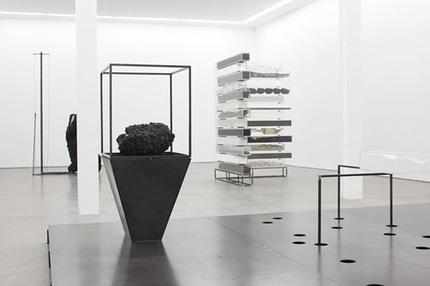
- Source: ARTFORUM
- Author: JULIE JONES
- Date: OCTOBER 20, 2011
- Format: DIGITAL
Nick van Woert at YVON LAMBERT BOOKSHOP
108, rue Vielle du Temple (October 20–November 19)

View of “Anatomy,” 2011.
“Anatomy,” Nick van Woert’s solo debut in Paris, offers a clever gambit that juxtaposes contemporary culture with the past. The Brooklyn-based artist uses building materials including concrete and stone, as well as highly structured objects made from industrial and organic materials, such as polyurethane, fiberglass, steel, and wood. The show, which is a tribute to Rembrandt’s The Anatomy Lesson of Dr. Nicolaes Tulp, 1632, stimulates the imagination, prompting viewers to take a closer look as they stroll among these hybrid, anthropomorphic sculptures. Despite their seeming simplicity, these works are by no means simple found objects; they are, rather, the obvious result of a sensitive and masterful use of materials.
Three untitled sculptures (all works 2011) are arranged on a platform. An amorphous object, which seems to have been overtaken by a black, gravellike substance, sits enthroned on an upside-down triangular pedestal. Adjacent to this work lies the white debris from a statue mold that has been subtly turned into a bony structure. In the middle of this stage, a transparent longitudinal square container filled with white powder rests horizontally on a stand with thin metallic legs. Its deathly rigidity evokes the seventeenth-century Dutch painter. But the work goes beyond such simple plays of association to suggest a reflection on commercial displays, Minimalism, and consumerism.
Nearby, an untitled architectural structure containing a symmetrical pile of rectangular clear vessels filled individually with asphalt, coal slag, burnt wood, cat litter, and soapstone, among other substances, simultaneously brings to mind a scientific manual and an IKEA catalogue; both classify objects and matter according to their characteristics until their original identity is lost. In a corner of the room, an installation titled Surveyor overlooks the entire scene. It strangely conjures a sculpture from antiquity and a measurement instrument used by early architects––two historical examples that the artist admires greatly.
Translated from French by Jane Brodie.

